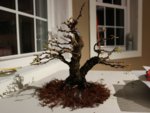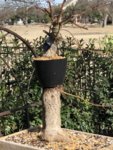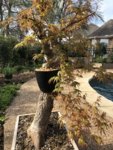AndyJ
Shohin
Hi folks,
Apologies for asking a question that's been answered before - well at least I think it has but I must be being an eejit as I can't find it on here!!
I've got an Arakawa that had a lot of top growth from last year - the tree was new to me so I didn't do anything with it, just "getting to know it." Anyway, I've pruned and wired it this year and have got a branch in the top that is too straight and needs to come off and I thought I'd airlayer it. Problem is, by the time the leaves are all out in 6-8 weeks, it's going to be very difficult to get in and set the layer. So, my question is, can I set it now? With no leaves on? If I can, do I just strip the bark and leave it? Or do I do the full strip and pack in sphagnum moss?
Thanks again and sorry for being repetitive if this subject has already been covered!
Andy
Apologies for asking a question that's been answered before - well at least I think it has but I must be being an eejit as I can't find it on here!!
I've got an Arakawa that had a lot of top growth from last year - the tree was new to me so I didn't do anything with it, just "getting to know it." Anyway, I've pruned and wired it this year and have got a branch in the top that is too straight and needs to come off and I thought I'd airlayer it. Problem is, by the time the leaves are all out in 6-8 weeks, it's going to be very difficult to get in and set the layer. So, my question is, can I set it now? With no leaves on? If I can, do I just strip the bark and leave it? Or do I do the full strip and pack in sphagnum moss?
Thanks again and sorry for being repetitive if this subject has already been covered!
Andy




